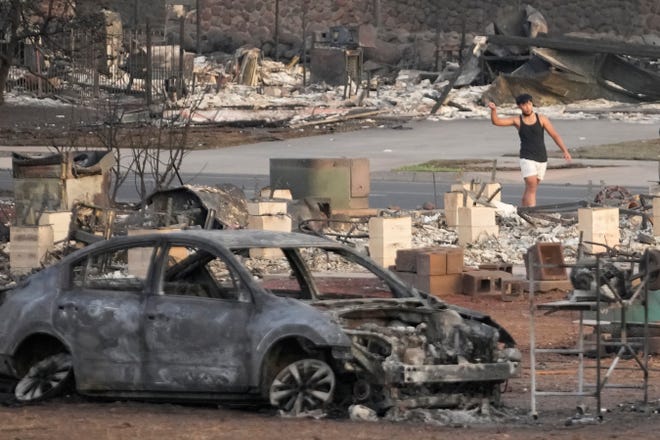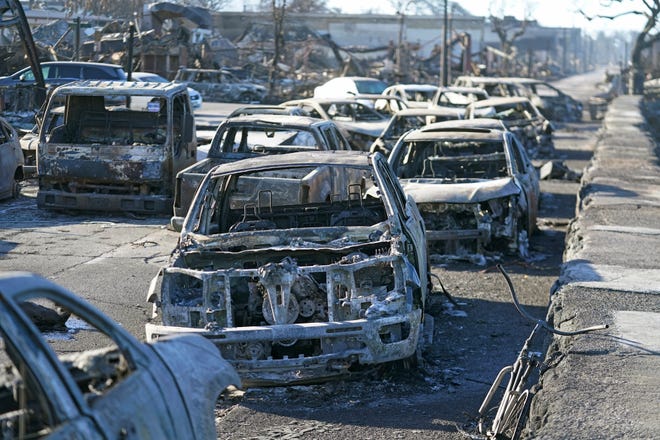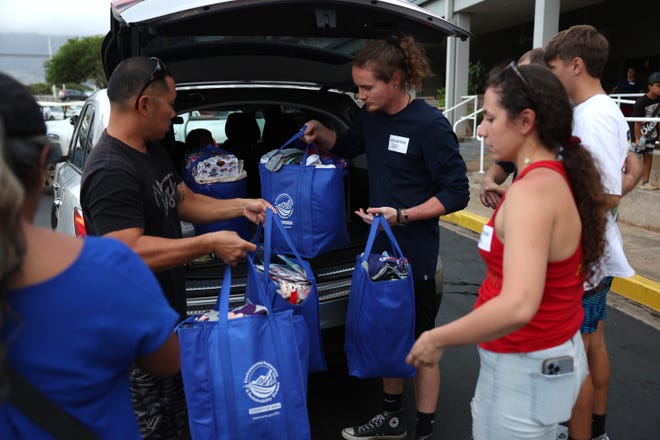
Things had started to look up for Maui after the COVID-19 shutdown that had doused its thriving tourist industry several years ago. Then came the trauma of this week’s deadly wildfires.
“We were just starting to rebound,” said Debbie Cabebe, CEO of Maui Economic Opportunity, a nonprofit agency based on the island. “Things were looking promising. The really sad part is there are still people missing and we don’t know what their status is. But we’re going to stick together and make it through this.”
Tuesday’s catastrophic blazes, fueled by hot, dry conditions and fanned by peripheral winds kicked up from a hurricane 500 miles to the south, is expected to become the worst disaster of Hawaii’s statehood, with 55 confirmed deaths thus far and close to 1,000 people still missing.
With the fires largely contained and the scope of the devastation starting to become clear, island residents are beginning to comprehend the economic challenges that lie ahead with thousands displaced and more than 1,700 structures destroyed. Hawaii Gov. Josh Green said he expected recovery costs to run into the billions with damages that will take years to repair.

“With this situation, the challenge is going to be that there are many people without homes,” Cabebe said. “Many of them are low-income, and there’s not enough homes and places to house them. That’s the biggest challenge facing our community now: Where are we going to put them? It’s going to take a long time to rebuild.”
Many homeless after fires, affordable housing crisis
Maui Economic Opportunity is reaching out to realtors and hotel managers, hoping to identify available units and unoccupied homes used seasonally by mainland owners that could house evacuees on a temporary basis. Maui’s worst fire damage occurred in the areas of Lahaina, Pulehu and Upcountry.
Much of the county has been struggling with affordable housing even before disaster struck last weekend. “Homes are extremely expensive and inventory is limited,” Cabebe said. “Now that we’ve lost thousands of homes and rental units, that’s just going to add to the problem. That’s something we’re going to have to figure out.”

Joe Kent, executive vice president for Grassroot Institute of Hawaii, a nonprofit policy research organization based in Honolulu, said the effect of the wildfires on the state’s economy will be immense, particularly given the destruction of much of the historic town of Lahaina, among the island’s primary engines of tourism.
“Maui’s west side was the main economic driver for the county,” said Kent, who once taught at Lahaina’s King Kamehameha III Elementary School, which according to reports was leveled by the blaze. “Now, thousands of people will be thrown out of work on the island with no place to live. This is billions of dollars in economic destruction.”
Cabebe described Maui, with a population of about 165,000, as an island community with a small-town feel, where everybody knows everybody.
“You go to Costco and see 15 or 20 people you know,” she said. “It’s somebody’s grandma or auntie or neighbor; there’s a lot of connectedness, and that’s what makes it a special place. The Maui community is very strong and supportive of one another. That’s what’s going to get us through this.”
Many were left struggling when the COVID-19 pandemic started in 2020. Officials shut down Hawaii’s tourism industry by requiring all incoming passengers to quarantine, and before long, state unemployment rates soared to 34%, among the highest in the nation.
Helping victims with small boats and jet skis
In the aftermath of the fires, Leonard Nakoa of Lahaina has been stuck in Honolulu, where he’d been visiting his brother, and hoped to return this weekend until the wildfires threw everything into question.
Instead Nakoa, a prominent community activist and sometime consultant driven by the fight for Native Hawaiian rights, has been constantly on the phone, doing what he can from afar. The main road into town has been shut down, so Nakoa said he’s been busy negotiating for supplies like gasoline and essentials to be delivered to Lahaina via an old fishing boat ramp in a narrow bay.
“Some of the boats are so big they can’t come to shore,” he said. “So I’ve got jet skis and small boats going in and out of the bay to pick stuff up and bring it in. Then I’ve got three distribution centers where they can go drop off supplies.”

It’s been maddening to be away, knowing his beloved hometown has been largely razed, especially given Lahaina’s place as the seat of the Hawaiian kingdom overseen by King Kamehameha III before the capital was moved to Honolulu in the 1840s.
Now, much of what was left of that heritage has turned to ash. Gone, too, is his daughter’s home although she and her family are all accounted for, he said, now sheltered at his countryside home at Lahaina’s outskirts.
‘The hotels are going to be empty’
Lahaina is unique even on Maui, with nearly a third of its population foreign-born, compared to just 18% for the island as a whole. Situated in West Maui, which has the highest rate of non-English speakers and the second-highest rate of households without a vehicle, the community Nakoa knows is harmonious and multicultural, a mix of Native Hawaiians, Filipinos, Tongans, Mexicans, Japanese and Chinese.
“We live among each other with no hatred,” Nakoa said.
But tourists and mainlanders with getaway homes on the island have torn at the fabric of that existence, he said, with land once dedicated to growing pineapple and sugarcane now overrun with sprawling mansions.

The relationship between Maui locals and tourists is a complicated one, he said, with residents both resentful of and reliant on the business that visitors bring. About one in six residents of Lahaina works in food preparation and service-oriented jobs, according to Data USA.
“I live it every day,” he said. “I hate it. “But we need the tourism for our living.”
Before, he said, you could drive from one end of the town and sense the difference, with stretches of dry, brown land peppered with the homes of Lahaina’s waiters, bellhops, cooks and housekeepers giving way to lush, green, tourist-populated areas flourishing under sprinklers and fountains. Now, much of it has turned to ash.
While the tourist industry has offered plenty of job opportunities, Nakoa said, keeping up with living expenses has been increasingly difficult when gas costs $5 a gallon and a jug of milk runs near $10. From 2017 to 2021, the average price of a home on the island was $677,000, according to U.S. Census data.
Now, with so much of the town destroyed, from the high-end homes near historic Front Street to the more affordable residences and low-income housing complexes beyond, he wonders where the income will come from.
“Front Street is all gone,” he said. “The hotels are going to be empty and tourists aren’t going to come. But we still have each other, and we’re going to make it.”
Meals, shelter, care needed for Maui residents
With the focus currently on emergency relief, Stephanie Fox, a spokeswoman for the American Red Cross said it’s too early to speculate about the housing and recovery complications that lie down the road.
“Things are still evolving and fluctuating by the hour,” Fox said. “We continue to provide safe shelter, meals, comfort and care for those impacted by this terribly tragic event and stand ready to navigate the coming days, weeks and months alongside the people of Hawaii.”

But the immediate need is clear, with state officials seeking as many as 2,000 rooms for temporary shelter and more than 4,000 people evacuated to shelters on Maui and beyond. Meanwhile, friends and relatives have launched verified GoFundMe pages seeking relief for Maui residents whose homes and businesses were incinerated by the blaze, such as the charter boat first mate who fled with only what they were wearing, a pair of expectant parents who lost two family homes and a family of six forced to abandon their guinea pigs and rabbits.
Another page sought relief for a Lahaina bar employee who’d gone door to door warning neighbors about the approaching blaze rather than spending time rounding up his valuables; the fire destroyed both his home and the bar where he worked.
Cabebe, of Maui Economic Opportunity, said she’s heard of many residents opening their homes to those displaced by the fires.
“They’re saying, ‘I’ve got a bed,’ or ‘I’ve got a couch,’” she said. “I saw a lady putting up a pup tent in her front yard and handing out food in Upcountry. But that’s the short term. Those of us who work in social services have to think about what the long term will look like.”
Contributing: The Associated Press






